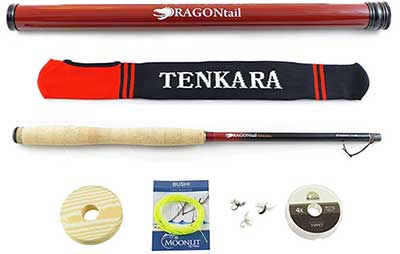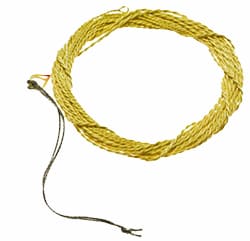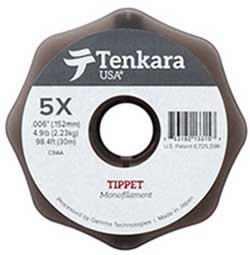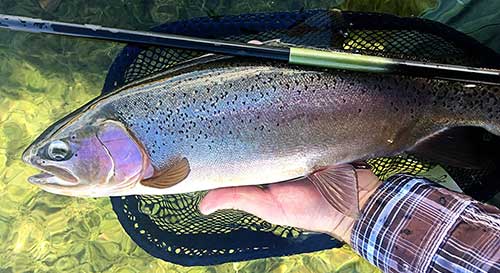Tenkara fly fishing is a traditional form of Japanese angling popular for centuries in the country’s mountain trout streams, but relatively unknown in America prior to 2009. Once an American company introduced it to western anglers it took the fly fishing community by storm- embraced by some, dismissed by others and misunderstood by many.
In the years since it has proven itself to be an enjoyable and simple alternative to traditional western fly fishing and has even been accepted by many jurisdictions as a legal technique for use in “fly fishing only” area. Let me give you a little background, explanation of necessary equipment and even some tips for making it more enjoyable for the beginner.
What is Tenkara?
Tenkara is often referred to as a simpler form of fly fishing and closely resembles early American cane pole fishing. Anglers use an extremely long pole and weighted line to cast flies without the use of a reel. Doing so makes Tenkara fishing appear odd when compared to western fishing, but also provides for a much shorter learning curve and exciting action when pursuing trout, bass or panfish in mountain stream or small ponds. Unfortunately although this type of angling does allow for an extremely up-close and personal experience it is not well suited for battling large species of fish or covering wide open areas.
A Rod, Line and a Fly
It doesn’t get any simpler than that.
The key to Tenkara fly fishing is the long, light pole used to cast the fly without the use of a reel. Although the set up appears simple, and it really is, there is a bit more to it than taking any old rod and tying a line to the tip. Each piece of equipment is specially designed to work in tandem and true results can only be achieved using authentic Tenkara gear.

Rod

Traditional Tenkara rods are between 11 & 15 ft. in length and constructed of a single piece of treated bamboo. Modern rods resemble these original bamboo models but are now constructed of carbon fiber, which equals or exceeds bamboo in both strength and light weight, and designed to telescopic so as to make transportation easier. Regardless of material used each will also be finished with a wooden or cork handle.
Line
As with western fly fishing the line used for Tenkara fly fishing is weighted, an aspect which assists in propelling and controlling the fly’s flight. Both traditional and modern Tenkara line is available in two versions: tapered furled and leveled. The tapered furled line is generally constructed from twisted monofilament and offers a more delicate presentation combined with ease of casting. The leveled line is made of specially designed fluorocarbon and although a bit more difficult to cast does perform better in windy conditions. Experts recommend trying both types of line and deciding which is best for you and your particular angling situation.

Flies
Of course as a form of fly fishing Tenkara fishing also utilizes artificial flies as the lure of choice. Traditional Tenkara flies resemble western flies and are often constructed using similar feathers, fur and yarns with one big difference, Tenkara flies often utilize a reverse hackle design which experts believe improves flight and action. Although some traditionalist insist on only true Tenkara flies more wildly available western flies do work well using this system so there is no need to relearn you fly tying techniques. However wet flies are vital to the overall technique and because you lack a reel or excess line to rip streams are an unlikely alternative.

Tippet
As with any form of fly fishing a tippet is necessary to connect the larger diameter line to the tiny fly. Although original Tenkara tippets were likely constructed of animal hair modern anglers have adopted the use of the same tippets used in western fly fishing, generally a 5x size between 1-3 feet in length.

Putting It All Together- the Tenkara Technique
Once you open your first Tenkara set up you will notice there is no assembly required, all you will need to do is attach the line to the rod, tippet to the line and fly to the tippet. Three simple knots and you will be ready to hit the water and each supplier provides easy to follow instructions as well as links to online tutorials.
The two biggest differences between western and Tenkara fly fishing involve the method of casting and how you land a fish, which are also the two aspects which seem to cause the most confusion among beginners. In reality each aspect is almost intuitive and very easy to master is you start by forgetting what you may already now about fly fishing.
Casting is achieved by way of a simple back and forth movements of the rod tip between the 10 and 2 o’clock positions. Similar to western fly fishing the line will gradually pick up momentum and cause the fly to extend towards the water where it is then gently dropped onto the surface. With a little practice most anglers find this technique to be easy to master, due primarily to the lack of extra line in need of management.

Landing a fish is similarly confusing but equally easy once practiced. When a fish takes the fly your first instinct is to pull back on the rod, setting the hook and preventing escape. When it comes to Tenkara fly fishing this is exactly what you need to do. Once the hook is set keep the rod tip held high, preventing the fish from throwing the hook, and then lean the rod away from the fish. As you do this the fish will be pulled closer and closer until it is within reach and can be retrieved.
Tenkara Fly Fishing Conclusion
So there you have it the nuts and bolts of Tenkara fly fishing. Now it’s time for you to get your own Tenkara set up and discover for yourself the joy of one of the ancient world’s most delicate forms of angling, something Japanese fishermen have been experiencing for centuries.